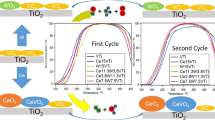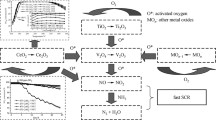Abstract
Chlorine species, widely presented in industrial flue gas such as the waste incineration plants, can poison the catalysts and affect the selective catalytic reduction (SCR) performance. In this work, effects of Cl on the SCR performance of V2O5–WO3/TiO2 (VW/Ti) catalysts were investigated by NH4Cl deposition. The results showed that the NOx conversion efficiency at low reaction temperature (< 300 °C) decreased with the loading of NH4Cl after calcination. It was found that instead of causing the chlorination of VW/Ti catalyst the NH4Cl decomposed into volatile Cl species due to the weak V–Cl bonding. Such decomposition reduced significantly the surface non-lattice oxygen species to inhibit NO adsorption and activation, but hardly affected the redox ability and acidity of VW/Ti catalyst. Time–resolved in situ DRIFTs results indicated that NH3 activation and the SCR process predominated by Eley–Rideal mechanism were not influenced with NH4Cl impregnation, while the SCR at low temperature following a Langmuir–Hinshelwood path was limited by the decreased and weaker binding sites for NO activation.






Similar content being viewed by others
References
Inomata Y, Kubota H, Hata S, Kiyonaga E, Morita K, Yoshida K, Sakaguchi N, Toyao T, Shimizu KI, Ishikawa S, Ueda W, Haruta M, Murayama T (2021) Bulk tungsten-substituted vanadium oxide for low-temperature NOx removal in the presence of water. Nat Commun 12:557
Qu WY, Liu XN, Chen JX, Dong YY, Tang XF, Chen YX (2020) Single-atom catalysts reveal the dinuclear characteristic of active sites in NO selective reduction with NH3. Nat Commun 11:7
Fang X, Qu WY, Qin T, Hu XL, Chen LW, Ma Z, Liu X, Tang XF (2022) Abatement of nitrogen oxides via selective catalytic reduction over Ce-1-W(1)atom-pair sites. Environ Sci Technol 56:6631–6638
Kang L, Han L, Wang P, Feng C, Zhang J, Yan T, Deng J, Shi L, Zhang D (2020) SO2-tolerant NOx reduction by marvelously suppressing SO2 adsorption over FedeltaCe1-deltaVO4 catalysts. Environ Sci Technol 54:14066–14075
Zhang YN, Zhu HC, Zhang T, Li J, Chen JJ, Peng Y, Li JH (2022) Revealing the synergistic deactivation mechanism of hydrothermal aging and SO2 poisoning on Cu/SSZ-13 under SCR condition. Environ Sci Technol 56:1917–1926
Jaegers NR, Lai JK, He Y, Walter E, Dixon DA, Vasiliu M, Chen Y, Wang CM, Hu MY, Mueller KT, Wachs IE, Wang Y, Hu JZ (2019) Mechanism by which tungsten oxide promotes the activity of supported V2O5/TiO2 catalysts for NOx abatement: structural effects revealed by V-51 MAS NMR spectroscopy. Angew Chem Int Ed 58:12609–12616
Xu L, Wang C, Chang H, Wu Q, Zhang T, Li J (2018) New insight into SO2 poisoning and regeneration of CeO2–WO3/TiO2 and V2O5–WO3/TiO2 catalysts for low-temperature NH3–SCR. Environ Sci Technol 52:7064–7071
Zhu M, Lai JK, Tumuluri U, Wu Z, Wachs IE (2017) Nature of active sites and surface intermediates during SCR of NO with NH3 by supported V2O5-WO3/TiO2 catalysts. J Am Chem Soc 139:15624–15627
Lee T, Oh JI, Kim T, Tsang DCW, Kim KH, Lee J, Kwon EE (2018) Controlling generation of benzenes and polycyclic aromatic hydrocarbons in thermolysis of polyvinyl chloride in CO2. Energy Conv Manag 164:453–459
Zhang JJ, Zhang SG, Liu B (2020) Degradation technologies and mechanisms of dioxins in municipal solid waste incineration fly ash: a review. J Clean Prod 250:15
Zhang H, Yu SY, Shao LM, He PJ (2019) Estimating source strengths of HCl and SO2 emissions in the flue gas from waste incineration. J Environ Sci 75:370–377
Chen JP, Buzanowski MA, Yang RT, Cichanowicz JE (2012) Deactivation of the vanadia catalyst in the selective catalytic reduction process. J Air Waste Manage 40:1403–1409
Yang NZ, Guo RT, Pan WG, Chen QL, Wang QS, Lu CZ, Wang SX (2016) The deactivation mechanism of Cl on Ce/TiO2 catalyst for selective catalytic reduction of NO with NH3. Appl Surf Sci 378:513–518
Wang P, Wang QS, Ma XX, Guo RT, Pan WG (2015) The influence of F and Cl on Mn/TiO2 catalyst for selective catalytic reduction of NO with NH3: a comparative study. Catal Commun 71:84–87
Xiong S, Chen J, Huang N, Yan T, Peng Y, Li J (2020) The poisoning mechanism of gaseous HCl on low-temperature SCR catalysts: MnO–CeO2 as an example. Appl Catal B 267:118618
Choung JW, Nam IS (2006) Characteristics of copper ion exchanged mordenite catalyst deactivated by HCl for the reduction of NOx with NH3. Appl Catal B 64:42–50
Lanza A, Zheng L, Matarrese R, Lietti L, Grunwaldt J-D, Clave SA, Collier J, Beretta A (2021) HCl-doping of V/TiO2-based catalysts reveals the promotion of NH3-SCR and the rate limiting role of NO oxidative activation. Chem Eng J 416:128933
Guo K, Zhu YX, Yan Z, Liu AN, Du XZ, Wang X, Tan W, Li LL, Sun JF, Tong Q, Tang CJ, Dong L (2020) The dual effects of ammonium bisulfate on the selective catalytic reduction of NO with NH3 over Fe2O3–WO3 catalyst confined in MCM-41. Chem Eng J 389:11
Guo SF, Huang ZW, Wang LP, Wu XM, Shen HZ, Jing GH (2021) MoO3/TiO2 catalyst with atomically dispersed O–Mo–O structures toward improving NH4HSO4 poisoning resistance for selective catalytic reduction of nitrogen oxides. J Hazard Mater 418:9
He YY, Ford ME, Zhu MH, Liu QC, Tumuluri U, Wu ZL, Wachs IE (2016) Influence of catalyst synthesis method on selective catalytic reduction (SCR) of NO by NH3 with V2O5–WO3/TiO2 catalysts. Appl Catal B 193:141–150
Lai JK, Wachs IE (2018) A perspective on the selective catalytic reduction (SCR) of no with nh3 by supported V2O5–WO3/TiO2 catalysts. ACS Catal 8:6537–6551
Zengel D, Stehle M, Deutschmann O, Casapu M, Grunwaldt JD (2021) Impact of gas phase reactions and catalyst poisons on the NH3-SCR activity of a V2O5–WO3/TiO2 catalyst at pre-turbine position. Appl Catal B 288:10
Niu Y, Liu Y, Tan H, Xiong Y, Xu T (2013) Origination and formation of NH4Cl in biomass-fired furnace. Fuel Process Technol 106:262–266
Xu W, Pan JF, Fan BW, Liu YX (2019) Removal of gaseous elemental mercury using seaweed chars impregnated by NH4Cl and NH4Br. J Clean Prod 216:277–287
Arfaoui J, Ghorbel A, Petitto C, Delahay G (2018) Novel V2O5–CeO2–TiO2–SO42− nanostructured aerogel catalyst for the low temperature selective catalytic reduction of NO by NH3 in excess O2. Appl Catal B 224:264–275
Nicosia D, Czekaj I, Krocher O (2008) Chemical deactivation of V2O5/WO3–TiO2 SCR catalysts by additives and impurities from fuels lubrication oils and urea solution—Part II. Characterization study of the effect of alkali and alkaline earth metals. Appl Catal B 77:228–236
Park GG, Chae HJ, Nam IS, Choung JW, Choi KH (2001) Deactivation of mordenite-type zeolite catalyst by HCl for the reduction of NOx with NH3. Microporous Mesoporous Mat 48:337–343
Wang Q, Lin F, Zhou J, Zhang J, Jin J (2020) Effect of HCl and o-DCBz on NH3-SCR of NO over MnO/TiO2 and MnO–CeO2/TiO2 catalysts. Appl Catal A 605:117801
Hess F (2021) Is there a stable deacon catalyst? Computational screening approach for the stability of oxide catalysts under harsh conditions. ACS Catal 12:497–511
Krishnamoorthy S, Baker JP, Amiridis MD (1998) Catalytic oxidation of 1,2-dichlorobenzene over V2O5/TiO2-based catalysts. Catal Today 40:39–46
Yao X, Wang Z, Yu S, Yang F, Dong L (2017) Acid pretreatment effect on the physicochemical property and catalytic performance of CeO2 for NH3–SCR. Appl Catal A 542:282–288
Cen W, Liu Y, Wu Z, Liu J, Wang H, Weng X (2014) Cl species transformation on CeO2(111) surface and its effects on CVOCs catalytic abatement: a first-principles investigation. J Phys Chem C 118:6758–6766
Chen L, Falsig H, Janssens TVW, Gronbeck H (2018) Activation of oxygen on (NH3–Cu–NH3)(+) in NH3-SCR over Cu-CHA. J Catal 358:179–186
Guo MY, Lis B, Ford ME, Wachs IE (2022) The effect of non-redox promoters (AlOx, POx, SiOx and ZrOx) and surface sulfates on supported V2O5–WO3/TiO2 catalysts in selective catalytic reduction of NO with NH3. Appl Catal B 306:10
Vuurman MA, Wachs IE, Hirt AM (1991) Structural determination of supported V2O5–WO3/TiO2 catalysts by in situ Raman spectroscopy and X-ray photoelectron spectroscopy. J Phys Chem 95:9928–9937
Chen L, Li J, Ge M (2011) The poisoning effect of alkali metals doping over nano V2O5–WO3/TiO2 catalysts on selective catalytic reduction of NOx by NH3. Chem Eng J 170:531–537
Kong M, Liu Q, Jiang L, Tong W, Yang J, Ren S, Li J, Tian Y (2019) K+ deactivation of V2O5-WO3/TiO2 catalyst during selective catalytic reduction of NO with NH3: effect of vanadium content. Chem Eng J 370:518–526
Liu H, Fan Z, Sun C, Yu S, Feng S, Chen W, Chen D, Tang C, Gao F, Dong L (2019) Improved activity and significant SO2 tolerance of samarium modified CeO2–TiO2 catalyst for NO selective catalytic reduction with NH3. Appl Catal B 244:671–683
Marberger A, Ferri D, Elsener M, Krocher O (2016) The significance of lewis acid sites for the selective catalytic reduction of nitric oxide on vanadium-based catalysts. Angew Chem Int Ed 55:11989–11994
Jia ZZ, Shen YJ, Yan TT, Li HR, Deng J, Fang JH, Zhang DS (2022) Efficient NOx abatement over alkali-resistant catalysts via constructing durable dimeric VOx species. Environ Sci Technol 56:2647–2655
Liu ZM, Zhang SX, Li JH, Zhu JZ, Ma LL (2014) Novel V2O5–CeO2/TiO2 catalyst with low vanadium loading for the selective catalytic reduction of NOx by NH3. Appl Catal B 158–159:11–19
Centeno MA, Carrizosa I, Odriozola JA (2001) NO–NH3 coadsorption on vanadia/titania catalysts: determination of the reduction degree of vanadium. Appl Catal B 29:307–314
He GZ, Gao M, Peng Y, Yu YB, Shan WP, He H (2021) Superior oxidative dehydrogenation performance toward NH3 determines the excellent low-temperature NH3-SCR activity of Mn-based catalysts. Environ Sci Technol 55:6995–7003
Topsoe NY, Topsoe H, Dumesic JA (1995) Vanadia/titania catalysts for selective catalytic reduction (SCR) of nitric-oxide by ammonia: I. combined temperature-programmed in-situ FTIR and on-line aass-spectroscopy studies. J Catal 151:226–240
Yan T, Liu Q, Wang S, Xu G, Wu M, Chen J, Li J (2020) Promoter rather than inhibitor: phosphorus incorporation accelerates the activity of V2O5–WO3/TiO2 catalyst for selective catalytic reduction of NOx by NH3. ACS Catal 10:2747–2753
Acknowledgements
The National Natural Science Foundation of China (Grant Nos. 22276215, 51938014) financially supported this work. The Fundamental Research Funds for the Central Universities, and the Research Funds of Renmin University of China (Grant No. 22XNKJ28) also supported this work.
Author information
Authors and Affiliations
Contributions
All authors reviewed the manuscript. Y.J. and W.C. designed the experiment and wrote the main manuscript. Q.L. and L.X. collected the experimental data. Y.Y. and C.H. prepared figures 3-5. W.C. and C.H. provided idea and guided all discussions.
Corresponding author
Ethics declarations
Competing Interests
The authors declare that they have no known competing financial interests or personal relationships that could have appeared to influence the work reported in this paper.
Additional information
Publisher's Note
Springer Nature remains neutral with regard to jurisdictional claims in published maps and institutional affiliations.
Supplementary Information
Below is the link to the electronic supplementary material.
Rights and permissions
Springer Nature or its licensor (e.g. a society or other partner) holds exclusive rights to this article under a publishing agreement with the author(s) or other rightsholder(s); author self-archiving of the accepted manuscript version of this article is solely governed by the terms of such publishing agreement and applicable law.
About this article
Cite this article
Yu, J., Qiu, L., Yin, Y. et al. Poisoning Effects of Chlorine on V2O5–WO3/TiO2 Catalysts for Selective Catalytic Reduction of NOx by NH3. Catal Surv Asia 27, 147–154 (2023). https://doi.org/10.1007/s10563-022-09386-4
Received:
Accepted:
Published:
Issue Date:
DOI: https://doi.org/10.1007/s10563-022-09386-4




